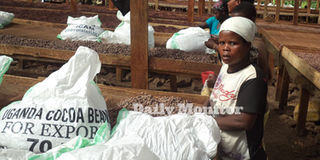International markets, price trends favour Uganda’s cocoa

Workers pack cocoa beans into bags at a facility in Bundibugyo District. Cocoa from Uganda is enjoying good prices and trader preference on the international market. PHOTO BY BRIAN SSENOGA
It may not be on the list of the top 10 priority crops for the last 10 or so years, but cocoa is by far one of Uganda’s leading foreign exchange earners. According to the latest figures from the Cocoa Development Project (CDP).
Joseph Kimera, a cocoa expert at CDP, under Ministry of Agriculture, Animal Industry and Fisheries, notes that compared to her competitors in the region and the continent, Uganda earns about 85 per cent of the international cocoa market price.
Not priority crop
Speaking to Daily Monitor at his office in Bugolobi, Kimera revealed that Uganda earned about $67m (Shs225.8b) last financial year yet it is not among the 12 crops which Uganda is giving priority. By September last year, a kilogramme of dried cocoa beans was trending at Shs9,600 up from Shs6,000 a year ago.
“Uganda earns the best of the world market price despite increase in production in the country. While other countries like Ivory Coast and Ghana get one dollar per kilogramme, we (Uganda) get three dollars. The norm is whenever there is an increase in production of any agricultural commodity, there tends to be a drop in prices but even with the bumper harvest of September farmers were still smiling,” he explained.
Strong performance
In addition, the 2014/2015 policy statement from ministry of Agriculture indicates Uganda’s cocoa exports more than doubled in the first half of the 2013/2014 financial year. This is 9,973 metric tonnes from 4,727 metric tonnes, which is exported in the first half of 2012/2013 financial year.
This was at the back of a strong performance in the second quarter where 57 per cent of exports were recorded. Earnings from cocoa followed a similar trend, increasing from $9m (Shs30.3b) in the first half of 2012/2013 to $17.2m (Shs58b) in the first half of 2013/2014.
Income generator
While cotton had a decline of 45 per cent in export values despite a 63 per cent increase in export quantities in the same period.
Revenue recorded from cotton in the first half of financial year 2013/2014 indicated $3m (Shs10b) a decline from $5.7m (Shs19.2b) recorded the previous year.
This makes cocoa the fourth highest revenue generator (nine per cent of total income) behind coffee, tourism and tea.
While production as of September last year stood at 24,008 metric tonnes, earning an estimated $67.8m (Shs228.4b) in export, Uganda targets $140m (Shs471.8b) by 2020.
Hectares and trees
But this, according to Kimera, can only be realised if close to seven million seedlings are planted apart from the three million a year as is the case with the Naads programme.
Information from the CDP indicates that there were 25,000 hectares of both young and mature cocoa as of June 2015. The target is 50,000 hectares by the end of 2020.
Carol Asiimwe, the project manager, Swisscontact, points out that there are about 38,000 cocoa smallholderfarmers in Uganda organised in producer business groups. In Bundibugyo District, for instance, there are 3,000 smallholder farmers organised in 51 producer cooperatives.
There are also 12 cooperatives registered with the Ministry of Trade, Industry and Cooperatives, and the number is growing. Uganda’s cocoa is exported mainly to Switzerland, Malaysia, Sri Lanka and Belgium. “Cocoa is becoming a very big and profitable enterprise in Uganda. The demand for cocoa and cocoa products is increasingly growing internationally mainly in China which is the biggest consumer of cocoa products worldwide,” Asiimwe says.
High price levels
“Even areas like Nakaseke and Rakai, which were not known for growing cocoa are now churning out huge tonnages,” adds Kimera. “It is unfortunate that we do not have a policy on cocoa despite the CDP having worked on the Issues Paper and the policy proposal.”
The November 2015 review of the cocoa market published by the International Cocoa Organisation (ICCO) showed the daily price averaged $3,361 (Shs11.3m) per tonne, up by $163 (Shs549,310) compared to the average price recorded in the previous month.
But all along Uganda maintained an average $3,182 (Shs10.7m) per tonme. These high price levels have not been seen since the period of the export ban imposed on Ivorian beans four years ago in the first quarter of 2011.
The new markets in China and other Asian economies give new prospects and benefits to the farmer today. This is coupled with the strong option buying interests from traders, which has also contributed to the bullish sentiment within both local and international market.
However, experts are worried about credibility of exporters and increased number of cocoa dealers in an unregulated industry. This is a challenge birthed by the government’s trade liberalisation policy allowing any individual to participate in the industry hence compromising quality.
Strong point
“Crop pests and diseases aside, the major challenge is the poor quality of cocoa on the market. This is partly related to a weak extension system that translates to poor post-harvest handling,” said Methodius Balyesiima, general manager, Semuliki Cooperative Union. “You find a farmer drying cocoa on ground instead of using a drying net. There is also information gap and the poor road network”
“Despite offering a good price, international buyers are not very happy with the quality but they continue offering better prices because of the alkalinity and a nice aroma of our cocoa and the bigger size of the bean,” he adds. “While cocoa from other producing regions like Asia and Latin America tend to have a certain level of acidity so they continue buying ours and mixing with the rest.”




